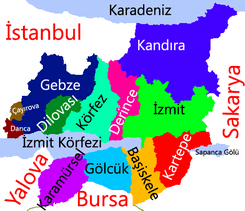Karamürsel
| Karamürsel | |
|---|---|
 Karamürsel | |
| Coordinates: 40°41′21″N 29°36′54″E / 40.68917°N 29.61500°ECoordinates: 40°41′21″N 29°36′54″E / 40.68917°N 29.61500°E | |
| Country |
|
| Province | Kocaeli |
| Area[1] | |
| • District | 289.22 km2 (111.67 sq mi) |
| Population (2012)[2] | |
| • Urban | 47,433 |
| • District | 52,621 |
| • District density | 180/km2 (470/sq mi) |
Karamürsel is a town and district located in northwestern Turkey, in the province of Kocaeli. The mayor is İsmail Yıldırım (AKP).
Karamürsel is on the coast of Izmit Bay and has beautiful shores. It has a famous basket known as Karamürsel basket, which is mainly used in collecting fruit like cherries, etc.. The characteristic of this handwoven basket is that it looks small to the eye but has a much bigger capacity than one would think.
Overview
Karamürsel is historically known as The Town of The Wrestlers, and was called for centuries Praenetos (Πραινετός in Greek) before its conquest by the Ottomans. It has also been well-known with its fish restaurants that also attract customers from nearby area. Handmade silk carpet production (the famous Hereke rugs are produced here too), fruit production (cherry, peach, plums, figs, pears, apples), and olive production are sources of income for the locals. It is not heavily industrialized like other parts of the province, and therefore Karamürsel's natural beauties are more intact compared to the rest of the province of Kocaeli.
The people living in Karamürsel and its villages are mainly Muslim Manav Turks and immigrants known as Muhacir in Turkish. On the other hand some immigrants came from Bosnia-Herzegovina, Bulgaria, Romania, Macedonia, Lazistan, Georgian, Circassia and Crimea, and arrived in the country during/after the fall of Ottoman Empire. Due to its rich ethnic structure it displays a wide array of cultures, heavily influenced by that of Balkan and Caucasus. Recently the town has also started attracting immigration from other parts of Turkey, especially from the Black Sea region.
Karamürsel was heavily damaged during the devastating 1999 İzmit earthquake (August 17, 1999) which rocked the eastern part of Marmara Region. 164 people lost their lives in Karamürsel in the earthquake, and many were left homeless. After the earthquake many people left this town for other parts of Turkey, and the place had a resemblance of a ghost-town for the winter of 1999. It is now returning to its old days, with the houses being repaired and the business being reopened. During the earthquake, a considerably damaging tsunami hit both the northern and southern sides of the İzmit bay in about one minute. Even the tsunami was not very large, subsidence and coastal landslides, have left a substantial portion of the towns of Gölcük, Degirmendere and Karamürsel inundated by the sea (Altinok et al., 1999). The coast of Karamürsel is now repaired and reconstructed.
Karamürsel has a very long history of being an important base for the navy. The first Ottoman shipyard was built on the Bay of İzmit in 1327 in Karamürsel. The ships built there constituted first nucleus of the Ottoman Naval Forces.
Due to its strategic and naturally protected location, Karamürsel has been used as a naval base that controls Black Sea. In addition a U.S. military base was located in Karamürsel for many years during the Cold War for the purpose of intercepting Russian radio transmissions. The station, containing a huge 500-foot-diameter antenna array AN/FLR-9, called Elephant Cage, was there from 1957 until 1979. This huge landmark was visible from everywhere in Karamürsel, from villages on the hills surrounding the town, and also from the shores across the Izmit Bay. After the US military left the base was transferred to Turkish Navy, and is still in operation today. The US military however took an important chip from the antenna, so that it would not be used after they left. The Turkish military eventually took out the antenna in the mid 1990s, however everyone still remembers this immense structure.
In 1958, a U.S. military dependents USDESEA Educational System school was opened on the Karamürsel Air Station. Beginning as an elementary level school, the school was eventually expanded to include middle school students and eventually included both junior and senior high school students. In 1961, a new school building was constructed and served the educational needs of the military personnel's children until the base itself was closed in 1979.
In addition to the students that lived on the base with their active duty parents, the American dependent's school on Karamürsel Air Station (KCDI) became a regional boarding school that now included grades nine through twelve. High school age students whose parents were stationed in other Turkish locations, those stationed in Iraklion Air Station, Crete, and the children of civilian federal employees that worked for the VOA (Voice of America) radio station in Xanthi, Greece now attended high school in Karamürsel. Housed in military barracks, the dormitory students were supervised by federal civilian employees referred to as dorm counselors.
Sport
The 2012 European Junior Open Water Swimming Championships were held from July 13 to 15 in Karamürsel. 117 swimmers from 21 countries participated at the event.
Notable natives
- Hakan Arıkan (born 1982), footballer
- Necdet Calp (1922-1998), civil servant and politician
- Sermet Erkin (born 1957), stage magician
See also
References
- ↑ "Area of regions (including lakes), km²". Regional Statistics Database. Turkish Statistical Institute. 2002. Retrieved 2013-03-05.
- ↑ "Population of province/district centers and towns/villages by districts - 2012". Address Based Population Registration System (ABPRS) Database. Turkish Statistical Institute. Retrieved 2013-02-27.
External links
- Belediye
- District's governor
- Karamürsel (Paul Dion's Karamürsel Website)
- Karamursel American School
- The American Military in Turkey
- Karamürsel Photographs
- KaramürselCity Local Web Site
- Karamürsel Photos
